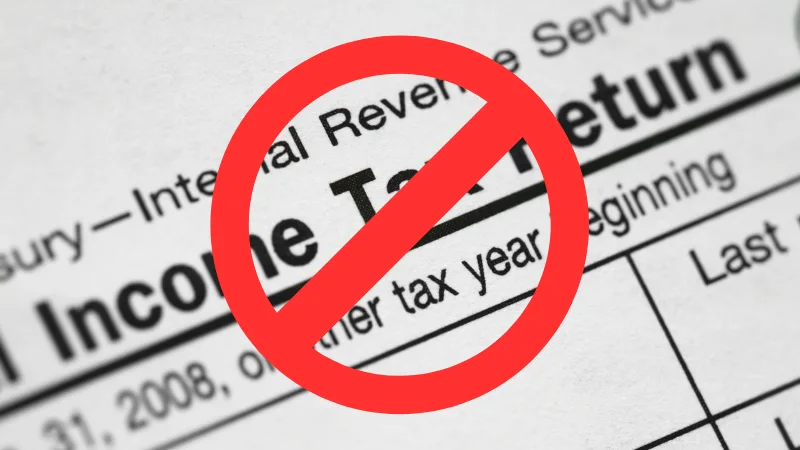President Donald Trump has floated a bold idea that keeps resurfacing in public speeches: replacing income taxes with tariffs. At a recent rally, Trump declared, “It’s possible we’ll do a complete tax cut” and fund government operations through tariffs alone, stating that tariffs could be “enough to cut all of the income tax.”
Free Today: Passive Income Strategies for 2025
Smart investors know passive income isn’t just nice to have — it’s critical in times like these. This FREE guide reveals proven dividend stocks and REITs that can help you build steady income with less stress. Discover simple strategies to put your money to work while you sleep…
Download Your Free Guide NowIt’s a provocative claim — but for investors, policymakers, and the broader economy, the critical question is: Could this actually happen without unleashing severe consequences?
The reality, as economic data and experts show, is that fully replacing the income tax system with tariffs is not just impractical — it would be economically devastating.
Let’s dive deeper into the numbers, history, and real-world risks investors must understand.
Understanding the U.S. Revenue Landscape
To grasp the challenge of Trump’s proposal, it’s essential to know where the government gets its money:
- In Fiscal Year 2024, the U.S. federal government collected approximately $4.92 trillion in revenue, according to U.S. Treasury data.
- Of that, individual income taxes accounted for roughly $2.7 trillion, or more than 50% of all federal revenue.
- Meanwhile, tariffs (customs duties) brought in only about $77 billion — less than 2% of total federal revenue (Forbes).
Bottom line: For tariffs to replace income taxes, the U.S. would have to multiply its tariff revenue by about 35 times — an economic stretch that would wreak havoc across industries and consumers alike.
Trump’s Vision: What He Said
Donald Trump has continued to emphasize tariffs as a way to alleviate the tax burden on Americans. During a recent appearance, he said:
“We’re going to be cutting taxes, and it’s possible we’ll do a complete tax cut because I think the tariffs will be enough to cut all of the income tax. Now, we have a lot of debt that’s been left to us, but we’ll take care of that with the tariffs.”
— Donald Trump, 2025 Rally
While the idea sounds politically attractive, it grossly underestimates the complex realities of trade economics, taxation, and global market responses.
A Historical Look: Tariffs Before Income Taxes
Trump’s concept isn’t without historical precedent — but times have drastically changed:
- Before the 16th Amendment introduced federal income taxes in 1913, tariffs were indeed the primary funding mechanism for the U.S. government.
- Between 1790 and 1910, tariffs funded 50% to 90% of federal expenditures, depending on the year (Forbes).
However, the 19th-century U.S. economy was small, predominantly agrarian, and had minimal government programs compared to today’s vast entitlements like Social Security, Medicare, and national defense.
In 2025, with a $25 trillion GDP and an interconnected global economy, relying solely on tariffs would be financial suicide.
Economic Implications: Why Investors Should Care
1. Inflationary Pressure
Tariffs are essentially taxes on imports. Raising them drastically would raise costs for businesses and consumers.
The Federal Reserve Bank of Boston estimates that Trump’s proposed “universal baseline tariffs” could increase core inflation by 0.5 to 2.2 percentage points, depending on enforcement levels and foreign retaliation.
For investors, inflation erodes real returns, raises interest rates, and destabilizes consumer spending — all negative for equities, bonds, and real estate.
2. Regressive Impact on American Families
Higher tariffs disproportionately impact lower and middle-income households, who spend a larger share of income on goods.
According to a Tax Foundation study, tariffs act as a regressive tax because they raise the prices of necessities like clothing, food, and household goods — without exemptions based on income level.
3. Retaliation and Global Trade Wars
Massive U.S. tariffs would likely provoke massive retaliatory tariffs from trading partners like China, the EU, and Mexico.
History already showed this during the U.S.-China trade war of 2018–2019, where American farmers, manufacturers, and exporters were crushed by China’s retaliatory measures.
If tariffs were jacked up enough to replace income taxes, the scale of retaliation would dwarf the 2018 episode, potentially costing millions of jobs and reducing U.S. GDP.
4. Supply Chain Chaos
Modern companies depend on global supply chains. Aggressive tariffs would disrupt sourcing, manufacturing, and distribution, driving up corporate costs — and hammering profit margins in industries from tech to retail to energy.
5. Stock Market Volatility
Markets hate uncertainty — and an abrupt tariff-based tax system would inject massive volatility.
Equities would likely fall sharply in response to lower corporate earnings, higher inflation, and increased recession risk, similar to how the Dow plunged during tariff announcements in past trade disputes.
What Experts Are Saying
The overwhelming expert consensus is that Trump’s idea is economically disastrous.
- Keith Maskus, Professor Emeritus of Economics at the University of Colorado Boulder, bluntly put it:
“If you tariff everything from everywhere, you’re going to get revenue generated. But you’re going to massively reduce trade, which will have massive negative economic consequences.”
(Yahoo Finance)
- The Tax Foundation calculates that even with a 20% universal tariff, the U.S. would only raise $2.6 trillion over a decade — still far short of what’s needed to replace even one year of income taxes.
- The World Trade Organization (WTO) has repeatedly warned that tariffs hurt the poorest the most, exacerbating inequality and global instability.
What Investors Should Watch For
If Trump’s proposal gains more traction, investors need to prepare:
- Hedge against inflation: Consider inflation-protected securities (TIPS), commodities like gold, or real assets.
- Review international exposure: Companies heavily reliant on imports or exports would face the most risk.
- Prepare for volatility: Safe-haven assets such as gold, Treasuries, and defensive stocks (healthcare, utilities) could outperform in a tariff-induced downturn.
- Monitor policy signals: While extreme tariffs are unlikely to pass Congress, aggressive trade policies could still roil markets.
Tariffs Alone Cannot Replace Income Taxes
While Donald Trump’s tariff proposal may resonate with tax-weary Americans, the numbers don’t lie: tariffs are nowhere near sufficient to replace income taxes without inflicting catastrophic damage on the U.S. economy and markets.
Investors should view such proposals with a skeptical eye and focus instead on how potential tariff policies — even partial ones — could reshape inflation, growth, corporate earnings, and portfolio risk.
Sound investing always starts with understanding economic reality, not political promises.





